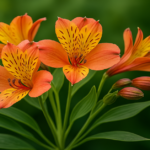Alstroemeria, commonly known as the Peruvian lily or lily of the Incas, is a vibrant and delicate flower beloved by florists, gardeners, and flower enthusiasts worldwide. Known for its striking patterns, long vase life, and rich symbolism, alstroemeria has become a staple in floral arrangements and gardens alike. Native to South America, particularly Chile and Brazil, this flower symbolizes friendship, prosperity, and devotion.
In this in-depth guide, we’ll explore the origin, characteristics, types, growing conditions, care tips, uses, and the symbolism of alstroemeria, along with frequently asked questions to help you better understand this captivating bloom.
The Origin of Alstroemeria
South American Roots
Alstroemeria was named after the Swedish baron and botanist Clas Alströmer, a close associate of Carl Linnaeus, the father of modern taxonomy. It was first discovered in the 18th century in South America, where it grows naturally in regions ranging from the cold Andes mountains to more temperate coastal climates.
Evolution and Hybridization
Since its discovery, alstroemeria has undergone extensive hybridization. Modern varieties have been bred for greater color diversity, durability, and adaptability. Today, alstroemeria hybrids are cultivated worldwide, with major commercial growers in the Netherlands, Kenya, Colombia, and California.
Botanical Characteristics
Physical Description
- Family: Alstroemeriaceae
- Genus: Alstroemeria
- Height: 1 to 3 feet tall
- Leaves: Alternately twisted leaves, giving the appearance of being upside down
- Flowers: Trumpet-shaped blooms with six petals, often marked with freckles or streaks
- Color Range: Pink, orange, red, purple, white, yellow, and bi-color combinations
Growth Habit
Alstroemeria is a tuberous perennial, which means it grows from underground storage structures. In ideal conditions, it can bloom from late spring to early fall, depending on the variety and climate.
Popular Alstroemeria Varieties
Alstroemeria ‘Apollo’
A popular white-flowered variety with light yellow and pink markings, ideal for weddings and elegant arrangements.
Alstroemeria ‘Indian Summer’
Noted for its copper-orange blooms and dark green-bronze foliage, this variety is both eye-catching and robust.
Alstroemeria ‘Inca Ice’
A hardy selection perfect for colder climates, featuring creamy peach blooms with delicate pink highlights.
Alstroemeria ‘Princess Series’
This dwarf variety is perfect for container gardening and smaller garden spaces, offering compact growth and vibrant colors.
Ideal Growing Conditions
Soil Requirements
Alstroemeria thrives in well-drained, fertile soil. A slightly acidic to neutral pH (6.0–7.0) is ideal.
Light Preferences
Full sun to partial shade. In hotter regions, partial shade during the hottest part of the day prevents leaf scorching.
Watering Needs
Moderate. Keep the soil consistently moist but not soggy. Overwatering can cause root rot, while underwatering may stunt growth.
Temperature Tolerance
Most alstroemeria varieties are hardy in USDA zones 6–10. Mulching can help protect roots in colder climates.
Planting and Propagation
Planting from Tubers
- Plant in spring after the last frost.
- Space tubers about 12 inches apart.
- Cover with 2 inches of soil and water lightly.
Propagation Methods
- Division: Dig up and divide the tubers in spring or fall.
- Seeds: Less common due to slow germination and unpredictable results.
Seasonal Care and Maintenance
Spring
- Start with fertilizing as new growth appears.
- Apply mulch to retain moisture and suppress weeds.
Summer
- Deadhead spent flowers to encourage continuous blooming.
- Stake taller varieties to prevent flopping.
Fall
- Cut back foliage after the first frost.
- Mulch for winter protection in colder zones.
Winter
- In mild climates, plants may remain evergreen.
- In colder regions, protect tubers with mulch or dig up and store indoors.
Pests and Diseases
Common Pests
- Aphids: Use insecticidal soap or neem oil.
- Spider Mites: Increase humidity and use miticides if necessary.
- Slugs and Snails: Manual removal or organic pellets can help.
Diseases
- Botrytis (gray mold): Improve air circulation and remove affected parts.
- Rhizome Rot: Avoid overwatering and ensure proper drainage.
- Leaf Spot: Treat with a fungicide and remove damaged leaves.
Alstroemeria in Floral Design
Popular Uses
- Bouquets: Common in mixed arrangements due to their long vase life.
- Weddings: Their symbolism of friendship makes them ideal for bridal bouquets and centerpieces.
- Home Decor: Adds color and elegance to indoor spaces.
Vase Life
Alstroemeria can last up to 14 days in a vase with proper care:
- Trim stems at an angle
- Use floral preservative
- Change water every 2–3 days
- Keep away from direct sunlight and ripening fruits
Symbolism and Cultural Significance
Symbolism
- Friendship: Commonly given to celebrate long-lasting friendships
- Devotion: Symbolizes mutual support and commitment
- Prosperity: A lucky flower for new beginnings and career growth
Cultural Relevance
In South America, alstroemeria is often used in traditional ceremonies and celebrations. Its vibrant colors and elegant structure make it a favorite in cultural floral displays.
Environmental Impact and Sustainability
Eco-Friendly Growing
- Grown without heavy pesticide use
- Low water requirements make it suitable for sustainable gardening
Commercial Farming
Modern alstroemeria farms use eco-conscious techniques, including drip irrigation, composting, and organic fertilizers to reduce environmental impact.
Interesting Facts About Alstroemeria
- Alstroemeria flowers are zygomorphic, meaning they have bilateral symmetry.
- The twisting of their leaves is a unique adaptation among flowering plants.
- Despite being called lilies, they are not true lilies (Lilium genus).
- In Victorian times, they were used to send secret messages through flower arrangements.
Conclusion
Alstroemeria, with its stunning beauty, diverse color palette, and rich symbolism, has earned its place as one of the most cherished flowers in horticulture and floristry. Easy to grow and long-lasting in floral arrangements, this flower brings joy, elegance, and meaning to gardens, homes, and celebrations across the globe.
Whether you are a gardener looking to cultivate these vibrant blooms or someone seeking a meaningful gift, alstroemeria offers both aesthetic pleasure and symbolic depth. With the right care and attention, these resilient plants can thrive and brighten any environment.
FAQs
1. How long do alstroemeria flowers last in a vase?
With proper care, alstroemeria can last up to 14 days in a vase.
2. Are alstroemeria flowers toxic to pets?
Yes, they can be mildly toxic to cats and dogs if ingested. Keep them out of reach of pets.
3. Can I grow alstroemeria in containers?
Yes, dwarf varieties like the Princess Series are ideal for containers.
4. When is the best time to plant alstroemeria?
Spring, after the last frost, is the best time to plant tubers.
5. Why are my alstroemeria not blooming?
Common reasons include insufficient sunlight, poor soil, or lack of nutrients.
6. Can alstroemeria survive winter?
In USDA zones 6–10, they can survive with mulch. In colder zones, tubers should be dug up and stored.







